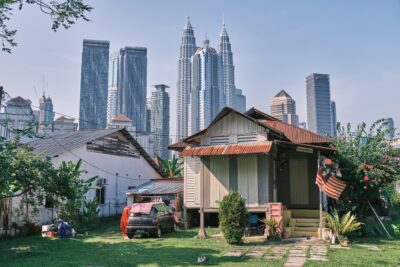Affordable housing sets the agenda in Asia-Pacific
Creating quality affordable homes in the region’s overheating cities has never been more urgent—which countries are stepping up to the plate?

Spanning roughly a third of the earth’s landmass, the Asia-Pacific region is home to more than 60 percent of the world’s population—and its rapidly growing cities are beginning to feel the pinch.
The urgent need to create quality affordable housing on limited land has become a defining issue across the region, where soaring property prices and stagnating incomes have left many struggling for a place to call home.
But 2018 brought several breakthroughs on this critical front. Recent elections ushered in new administrations in Hong Kong, New Zealand, and Malaysia, all promising to cure their respective housing crises as a top priority.
Innovative design and urban planning firms have cropped up across Asia, breathing new life into mass housing developments and putting sustainability front and centre.
Singapore’s public housing scheme, created in the 1960s, still shines as the region’s gold standard. Today, more than 90 percent of the city-state’s 5.6 million residents are homeowners. While the Singapore model isn’t easily exportable, many of its neighbours are finding their own unique solutions.
Malaysia suffers no shortage of innovative developers; with more land and lower costs than neighbouring Singapore, the Southeast Asian nation seems to be enjoying a steady emergence from its years-long property malaise.
Political headwinds may have helped. In May, Malaysian voters decisively ousted the administration of former Prime Minister Najib Razak, who was deeply embroiled in the 1MDB embezzlement scandal. The new government of Mohammad Mahathir, who returned to power at the age of 93 on a promise of cleaning up corruption and shoring up investor confidence, swiftly began a wholesale undoing of Najib’s policies.
Home-grown firms were more than ready for change, and have seized the opportunity. LBS Bina Group, based in Kuala Lumpur, is among the most prolific when it comes to creating large scale, community-oriented housing, launching successful projects in the Klang Valley, Johor, and Kuala Selangor.
LBS Bina swept this year’s Property Guru Asia Property Awards, recognized as Malaysia’s Best Developer and making off with a cache of other honours for innovation in mass-market condominiums, corporate social responsibility, and sustainability.
Having already gained a strong foothold, the firm now seeks to lead the way by lowering construction costs through an industrialized building system of pre-cast concrete that reduces the need for labour. Ong Wei Ling, a spokesperson for LBS Bina, says the method results in “cleaner, neater, and safer construction sites” completed in a fraction of the time, “helping developers deliver value to investors or buyers awaiting their dream home.”
Other firms such as UEM Sunrise Berhad, one of Malaysia’s largest developers, and OCR Berhad Group have been among the most strident designers of affordable housing, the latter serving as project manager for the massive Yayasan Pahang development in Mukim Penor. Once completed, it is expected to create roughly 25,000 units.

Smaller than the U.S. state of Rhode Island, with nearly seven times the population, Hong Kong is home to about 7.4 million people crammed into 2,754 square kilometres packed with high-rises divvied up into miniscule units. Year after year, this semi-autonomous region of China is named one of the most expensive cities in the world, a vital gateway between East and West that costs an average of USD28,000 per square meter.
“The Hong Kong problem is quite unique and is complicated by the fact that Hong Kong just doesn’t have enough land,” says David Ji, director and head of research and consultancy for greater China at Knight Frank. “They have to squeeze as much out of it as they can.” This conundrum has put Hong Kong’s policymakers in the uncomfortable position of having to either create new landmasses or convert older properties for new use.

Chief Executive Carrie Lam, who assumed the territory’s highest office in 2017, has said solving the city’s housing crisis is among her top priorities. While plans to build affordable housing on roughly 1,700 hectares of artificial islands—a project called Lantau Tomorrow Vision—have come under criticism, she may have few viable alternatives to land reclamation. Property experts say Lam has made strides with long-term housing goals, but is bound to face opposition because she has yet to come up with short-term solutions to help the many Hong Kongers who need homes now.
“A comprehensive proposal has been tabled, which has never happened before, and as a long-term proposal this is a positive step,” says Ji. “But all these measures are planned far in the future, we’re looking at five to 10 years down the line, and buyers still find it difficult to get on the property ladder.” While prices have risen for 20 consecutive months, Ji says he expects some relief by year’s end.
PEOPLE ARE RETHINKING AFFORDABLE HOUSING—NOT AS A BURDEN THAT NOBODY WANTS TO BUILD, BUT TRYING TO PUT AFFORDABLE HOUSING INTO PRIVATE DEVELOPERS’ PLANS
Several governments in the Asia-Pacific have also moved to limit foreign ownership—due in part to concerns about Chinese expansionism—but experts say these policies are misguided. New Zealand’s recent ban on foreign residential sales prompted the International Monetary Fund to warn that the policy was discriminatory.
When Malaysian premier Mahathir suggested curbing foreign ownership of units in the USD100 billion Forest City project, the idea sent a chill through the investment community. “Permitting foreign investors to buy new housing obviously increases demand for housing,” says Brendan Coates, a fellow at Melbourne-based think tank the Grattan Institute, “but supply also increases if foreign investors enable developers to build more housing than otherwise.”
China’s own reform of land and financial policies are working to keep investors well within its borders. Outbound capital limits have led many Chinese to invest closer to home, while land use regulations have been altered to require a percentage of mixed-income housing on large scale property developments to meet growing demand.
“I think in the greater China region, people are rethinking affordable housing—not as a burden that nobody wants to build, but trying to put affordable housing into private developers’ plans,” says Ji, of Knight Frank. “The trend is changing from ‘whoever pays the highest price gets the land,’ to a more targeted, controlled use of property.”
This issue originally appeared in Issue No. 151 of PropertyGuru Property Report Magazine
Recommended
Meet the vagabond architect behind India’s housing scene
Vinu Daniel is helping to shake up India’s home building setting
Where Asian real estate stands in a fragmented, warmer world
Asia’s real estate industry faces many and varied challenges as external factors continue to bite
6 sights to see in Singapore’s Marine Parade
Handily located Marine Parade has emerged as a vibrant investment choice in the Lion City
There’s a township dedicated to health and wellness in Malaysia
Property seekers have their health needs catered for at KL Wellness City








